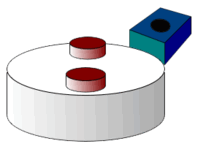
Photo from wikipedia
BK channels uniquely integrate voltage and calcium signaling in diverse cell types through allosteric activation of their K+-conducting pore by structurally distinct V and Ca2+ sensor domains. Here, we define… Click to show full abstract
BK channels uniquely integrate voltage and calcium signaling in diverse cell types through allosteric activation of their K+-conducting pore by structurally distinct V and Ca2+ sensor domains. Here, we define mechanisms and interaction pathways that link V sensors to the pore by analyzing effects on allosteric coupling of point mutations in the context of Slo1 BK channel structure. A gating lever, mediated by S4/S5 segment interaction within the transmembrane domain, rotates to engage and stabilize the open conformation of the S6 inner pore helix upon V sensor activation. In addition, an indirect pathway, mediated by the carboxyl-terminal cytosolic domain (CTD) and C-linker that connects the CTD to S6, stabilizes the closed conformation when V sensors are at rest. Unexpectedly, this mechanism, which bypasses the covalent connections of C-linker to CTD and pore, also transduces Ca2+-dependent coupling in a manner that is completely nonadditive with voltage, analogous to the function of a digital logic (OR) gate.
Journal Title: Science Advances
Year Published: 2022
Link to full text (if available)
Share on Social Media: Sign Up to like & get
recommendations!